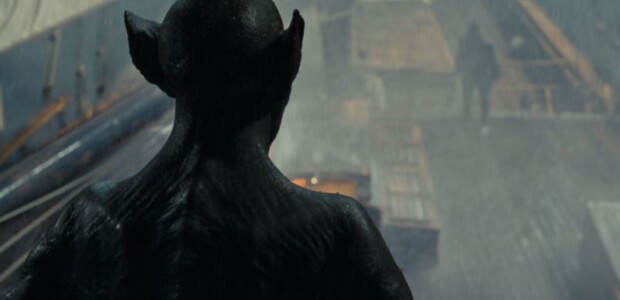Despite being a brief, insubstantial stretch of Bram Stoker’s DRACULA, the episode detailing the Demeter — the doomed vessel that transports the bloodsucking count from his native Transylvania to England — has produced some of the most evocative on-screen imagery for over a century: the iconic, haunting shots of Orlok and the derelict vessel in both Murnau and Herzog’s NOSFERATU, the ghastly image of Dwight Frye’s Renfield maniacally laughing in the ship’s bowels in Tod Browning’s 1931 film, Frank Langella’s throat-ripping exploits in John Badham’s 1979 update, the blood-soaked masts in BRAM STOKER’S DRACULA. Something about this part of the novel captures the imagination perhaps because Stoker leaves so much of it to the imagination, and these fleeting cinematic images capture the enigmatic space the Demeter occupies in Dracula lore. Even if these films don’t dwell on this particular chapter any more than Stoker himself did, it’s easy to see the appeal of a vampire stalking its victims on the raging high seas, which is likely part of the reason Hollywood has spent the past two decades trying to bring it to the screen as a full-length feature.
During that time, a lot of people dedicated themselves to an entire movie of Dracula raising hell on a boat, with the task eventually landing in the lap of André Øvredal, director of recent horror favorites THE AUTOPSY OF JANE DOE and SCARY STORIES TO TELL IN THE DARK. It’s an inspired pairing, especially since Universal really lets him run loose to craft a lavish, gnarly gothic horror movie that pulls few punches as it reconfigures Stoker’s chapter into THE LAST VOYAGE OF THE DEMETER, an impressively mounted claustrophobic creature feature. It features Dracula at his most primal, an inhuman bloodsucker that exists to feed and sow chaos among the crew of the Demeter as he picks them off one by one. The film is sure to earn comparisons to ALIEN, which isn’t unwarranted, especially since Øvredal approaches the material in the same way Ridley Scott did by foregrounding the human element before putting it through a grinder.

It opens with the titular vessel crashing on shore, the driving rain and howling wind providing a most appropriate soundscape for this derelict haunted house. From its captain’s log, we learn that some horrible, mysterious plague has fallen upon the vessel, drawing us into an extended flashback that starts with the ship’s departure from Bulgaria, where first mate Wojchek (David Dastmalchian) gathers a crew. Among them is Clemens (Corey Hawkins), a Cambridge grad and a doctor who’s granted passage after he saves Captain Elliot’s (Liam Cunningham) grandson (Woody Norman) from being crushed to death by the ship’s cargo. He joins a motley crew of working-class men who hope to make some extra fortune by arriving in London within a month, a proposition that quickly becomes unlikely when they discover Anna (Aisling Franciosi), an unwitting stowaway who cryptically murmurs in her fevered state. Following a blood transfusion, she becomes more lucid, and her message is clear: Dracula (Javier Botet) — an old legend from her homeland — is aboard the ship, which will never reach the shore.
THE LAST VOYAGE OF THE DEMETER is striking in the same manner as Øvredal’s past work because the production design is immediately absorbing, creating the impression that we’re dropping into a rich, lived-in world. From the moment we see the Demeter crash against the wind-swept cliffs of Whitby, we’re transported into an evocative, gothic vista that rarely relents in building atmospheric dread. The Demeter itself is a wonderfully spooky old haunt, full of nooks, crannies, creaks, and groans, just like a proper haunted house that just happens to be drifting through the ocean on a damned voyage. I have to imagine this premise is part of the reason this project hung around in development hell for twenty years — it’s a damn clever way to approach a familiar genre, especially when you add one of horror’s most iconic fiends into the mix. Part haunted house movie, part creature feature, THE LAST VOYAGE OF THE DEMETER is a full-on melodramatic, gothic freak show, draped in shadows and fog, soaked in driving rain and wanton bloodshed. Øvredal cuts right to the heart of what makes Stoker’s novel so elementally terrifying by stripping the Count’s deceptive veneer of respectability: he’s simply a force of nature that goes right for the throat here, a truly wicked hellspawn.
It helps that you give a damn who Dracula’s sinking his teeth into. Some of the names, like Olgaren (Stefan Kapicic) and Petrofsky (Nikolai Nikolaeff), are sourced from the novel, but everyone involved is more fleshed out, including the captain himself, who’s actually unnamed in the Stoker’s text. Here, Captain Elliot is the veteran steward of the Demeter who plans on making this voyage his last before retirement (it turns out this cliche isn’t just reserved for police in cop movies!), and Cunningham plays him as a warm-hearted, doting grandfather to little Toby. He’s also planning on handing the Demeter over to Wojchek, his first mate who’s a little bit more rough around the edges.
Dastmalchian (who is having quite a year!) doesn’t allow him to lapse into an unrepentant bastard though — he’s just an old, superstitious salty dog who doesn’t want to miss out on a big payday, and his attachment to the Demeter itself becomes a potent source of tension down the stretch. There’s also a pious cook (Jon Jon Briones) who brings big Crazy Ralph energy to the ship once it’s under siege. The rest of the crew is properly rugged, and a pivotal dinner scene sketches a vivid portrait of mercenaries looking to line their pockets so they can indulge in simple pleasures once they reach the shore. It’s another obvious echo of ALIEN, this collection of blue-collar grunts just looking to complete a job that’s set to go haywire, and it effectively provides some stakes to the looming carnage.
Hawkins distinguishes himself in more ways than one as Clemens, a Black med school grad who’s never been able to practice because of the color of his skin, leaving him to seek any kind of purpose in the world, a struggle that cleverly embodies the thematic subtext that makes DRACULA such a fascinating proposition. Published and set just a few years before the 20th century, the novel wrestles with a recurring theme of 19th-century British literature: the tension between past and present, between the arcane and the modern, between superstition and progress. Written in peak Victorian epistolary form, it juxtaposes a realist style with fanciful, old-world horrors, suggesting that, for all our progress, we’re still drawn to the unknowable and the unexplained. As a man of reason, Clemens thinks all of his answers can be found in science, much to the chagrin of his more superstitious shipmates. His journey isn’t unlike many of the characters’ arcs in DRACULA, as he has to confront this unfathomable evil that exists without rational explanation, and Hawkins brings tremendous charisma to the role. He’s righteous but steadfast in depicting Clemens as a formidable foe for Dracula, to the point where he almost feels like a Van Helsing surrogate, and his rapport with Franciosi is the crux of the film’s emotional undercurrent.
Then there’s the bloodsucker himself, twisted into an even more grotesque version of NOSFERATU’s Orlok as the effects crew imagines him quite literally to be a giant bat. It’s an inspired choice, largely because it allows Øvredal to lean into the script’s monster movie approach. There’s no seduction here, nor is there any attempt by Dracula to ingratiate himself to the crew — he’s just here to feast on their flesh and bones. Øvredal is careful to confine him to the shadows and give him a phantasmal presence, heightening his boogeyman quality. Botet has authored a number of indelible creatures over the past decade, and his Dracula is a unique take on arguably the most familiar monster of all time. His Dracula has no time to mince words, but a sense of perverse glee emerges in his monstrous, inhuman visage nonetheless — there’s still something entirely dastardly about his Dracula.
He also wreaks absolute havoc aboard the Demeter. THE LAST VOYAGE earns its stripes as a Dracula tale by laying absolute waste to its doomed ship. If Dracula doesn’t completely rip someone’s throat out, spilling their blood all over the deck, then he leaves them to linger on in agony before meeting a fiery, flesh-searing fate. The fatalistic premise of adapting a chapter from a book that leaves no survivors hovers over the film, haunting it with a perceptible, inexorable doom: THE LAST VOYAGE OF THE DEMETER is a relentlessly bleak, nasty piece of work that revels in a grisliness that’s accented by melodramatic grace notes, solidifying its gothic bonafides. More than anything, I love that Øvredal envisions this as a big, dramatic production in the Hammer tradition: despite the claustrophobic setting, there’s a sense of grand guignol grandeur to it that speaks to his sensibilities as a filmmaker. He has all the tools of a great horror director, and he confidently deploys them throughout a movie that has him meticulously orchestrating jolts and staging gory outbursts.
The setting sometimes works to the film’s detriment: there are at least a couple of shots where the murky photography obscures the action, and the story starts to feel a little stretched beyond its means down the stretch (a little long in the fang if you will). But these are fairly minor quibbles, especially since the length contributes to the epic, lived-in quality of the film: if nothing else, Øvredal stretches his legs and invites you to luxuriate in this lush, textured production. For nearly two hours, you’re transported right into the most elementally terrifying stretch of Stoker’s novel, where ghastly horrors unfold relentlessly and without explanation. Stripped of the novel’s letters, newspaper clippings, and journal entries that provide context for Dracula’s motivations and plot, THE LAST VOYAGE OF THE DEMETER is free to be a rip-roaring horror show that earns its place in the Universal Monsters pantheon. I know the ill-fated Dark Universe has become the butt of so many jokes, but this feels like the way forward for the studio’s iconic stable of monsters: cool updates and riffs on familiar themes that feel both faithful and fresh all at once. Between this and Leigh Whannell’s THE INVISIBLE MAN, Universal has a path — now let’s hope they continue to explore it.
Tags: Aisling Franciosi, André Øvredal, Bear McCreary, Bragi F. Schut Jr., Bram Stoker, Bulgaria, Corey Hawkins, David Dastmalchian, Dracula, England, Horror, Javier Botet, Jon Jon Briones, Liam Cunningham, Nikolai Nikolaeff, Patrick Larsgaard, Stefan Kapi?i?, The Sea, Tom Stern, Transylvania, vampires, Woody Norman, Zak Olkewicz



No Comments